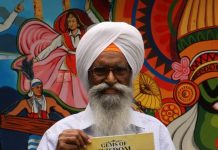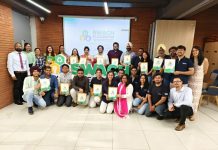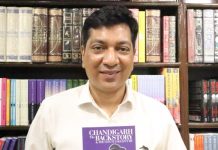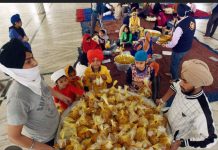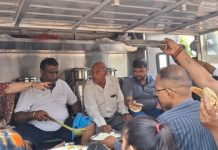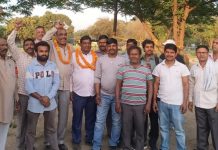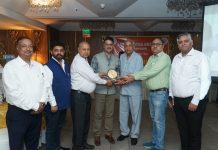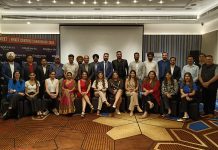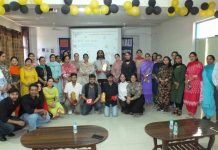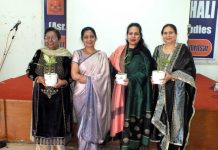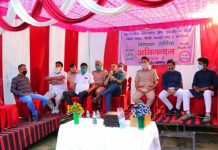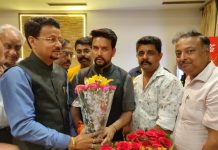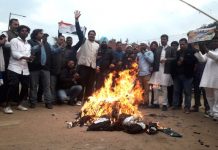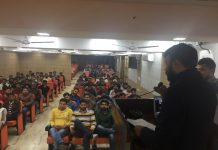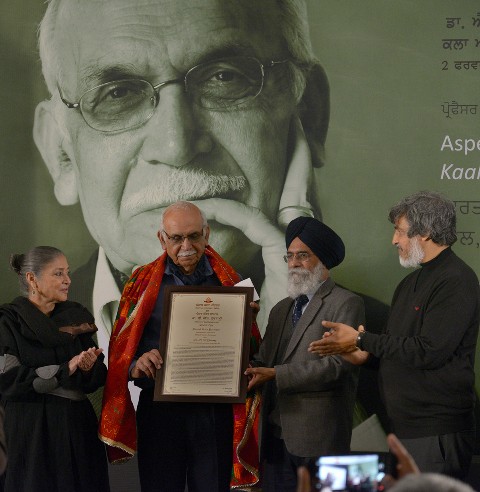Chandigarh
6 February 2018
DIVYA AZAD
Internationally acclaimed art historian and thinker Professor B. N. Goswamy gave an audio visual presentation and Dr. M S Randhawa Memnorial Lecture, on the theme of “Aspects of Time in Indian painting: Kaala, Samay, Waqt” at Punjab Kala Bhawan, Chandigarh on the invitation of Punjab Kala Parishad and Punjab Lalit Kala Akademi during the ongoing Dr. M. S. Randhawa Kala ate Sahit Utsav 2018 (Dr. M. S. Randhawa Arts and Literature Festival 2018) .
Professor B. N. Goswamy was also be conferred Punjab Gaurav Sanmaan by Punjab Arts Council for his distinguished contribution in the field of art with a plaque, citation and a cheque of rupees one lakh. Mr. Surjit Patar, Chairman Punjab Arts Council conferred the Punjab Gaurav sanmaan upon Dr. Goswamy along with Diwan Manna and Neelam Man Singh Chowdhury.
Professor Goswamy talked about various facets of time and the notions we have about time. He gave examples of scriptures and explained in detail, with carefully chosen visuals of Indian miniature Paintings, on how Indian Painters of earlier times were able to describe Time visually in their paintings. For instance all the Ten Sikh Gurus are shown sitting together in one painting from the Sikh Miniature paintings – Gurus belonging to different times shown at one time. Similarly Krishna or Govind shown in various stages in one narrative.
Diwan Manna , artist and President Punjab Lalit Kala Akademi spoke about how Professor Goswamy has been instrumental in introducing the finer nuances of Indian Art to the rest of the world. He has brought the focus on Indian artists and made them get importance in the eyes of the western art historians, scholars and cultural theorists. He also said that Prof. Goswamy is the most distinguished art historian after Anand Kentish Coomaraswamy in last century.
The specially set up arena for this very special lecture was choko block with discerning audience and each word of Prof. Goswamy was listen to with rapt attention.
Professor Brijinder Nath Goswamy is India’s most distinguished art historian today. His work, in the areas of research and teaching, has influenced a whole generation of scholars active in the field. He has pioneered different ways of seeing, and thinking about, the art of the past, and established clear new paradigms in the area of art historical research. It is as a result of his ceaseless efforts that the Indian artist of the past has begun slowly to emerge from the dense fog of anonymity, and to be recognized as a thinking individual, capable of, and interested in, taking creative decisions.
Prof Goswamy has been a visiting Professor to various prestigious Universities the world over and written numerous books on the subjects of Indian Art during a distinguished career of more than 60 years.
Professor Brijinder Nath Goswamy is India’s most distinguished art historian today. His work, alike in the areas of research and teaching, has influenced a whole generation of scholars active in the field. He has pioneered different ways of seeing, and thinking about, the art of the past, and established clear new paradigms in the area of art historical research. It is as a result of his ceaseless efforts that the Indian artist of the past has begun slowly to emerge from the dense fog of anonymity, and to be recognized as a thinking individual, capable of, and interested in, taking creative decisions.
Born on the 15th of August, 1933, to Kaushalya and B.L. Goswamy at Sargodha, in undivided Punjab, Professor Goswamy was educated entirely in India, and received his Master’s and Doctoral degrees from the Panjab University, creating new academic records. In 1956, he was selected for, and joined, the Indian Administrative Service, but resigned from that service in 1958 to return to teaching. His first teaching assignment abroad at the University of Kiel in Germany resulted in his being drawn, and shifting his attention, to a field then virtually unknown in India: that of art history. Upon his return to India in 1963, he became instrumental in founding, at the Panjab University, the Department of Art History, which has played a major role in establishing this discipline in the country since then. Appointed as Professor of Art History at the Panjab University in 1967, Dr. Goswamy has continued to teach and research ever since. He has been Visiting Professor of Art History at a number of Universities abroad, including the University of Heidelberg in Germany; the Universities of Pennsylvania at Philadelphia, California at Berkeley and Los Angeles, and Texas at Austin in the United States; and the University of Zurich in Switzerland. Professor Goswamy was elected Fellow of the Royal Society of Arts, and the Royal Asiatic Society. He has also acted as Commissioner and Guest Curator of major international exhibitions: among them, those at the Museum Rietberg in Zurich, the Musee Guimet in Paris, the Museum of Asian Art in San Francisco, the San Diego Museum of Art, the Museum of Applied Arts in Frankfurt, the Rubin Museum of Art, and the Metropolitan Museum of Art, in New York.
Over all these years, Professor Goswamy has been continuously researching and writing. There is a major body of work on Indian art associated with his name. From among the more than twenty-five books he has written till now, a large number have become benchmarks, drawing significant national and international attention. Among these are Pahari Painting: The Family as the Basis of Style (Mumbai, 1968); Painters at the Sikh Court (Wiesbaden, 1975); The Essence of Indian Art (San Francisco, 1986); Pahari Masters: Court Painters of Northern India (Zurich, 1990);Indian Costumes in the collection of the Calico Museum of Textiles (Ahmedabad, 1993); Nainsukh of Guler: A great Indian Painter from a small Hill State (Zurich, 1997); Piety and Splendour: Sikh Heritage in Art (Delhi, 2000); Domains of Wonder (San Diego, 2005); The Word is Sacred/Sacred is the Word (Delhi, 2006), Wondrous Images: Krishna as Shrinath ji (Ahmedabad, 2014); and The Spirit of Indian Painting (Penguin and Thames & Hudson, 2014). His most recent work, Manaku of Guler: Another Great Indian Painter from a Small Hill State (Zurich and Delhi, 2017) was released a few short months ago.
For work and achievements in the field of art history, and for his brilliant educational record, Professor Goswamy has received wide recognition. Besides the honour of being invited as Visiting Professor by a number of leading Universities abroad, he has held many prestigious Fellowships: among them the Jawaharlal Nehru Fellowship, the John D. Rockefeller Fellowship, and the Mellon Senior Fellowship. In 1998, Professor Goswamy was awarded the Padma Shri by the President of India. He has been President of the Indian Association of Art Historians, has delivered several endowed lectures in India and abroad, and been a Trustee of major Foundations. In the year 2000, Professor Goswamy was given the Rietberg Award in Switzerland for Outstanding Research in Art History, and in 2008, he received another national honour, the Padma Bhushan, from the President of India. The Sangeet Natak Akademi conferred upon him the Tagore Fellowship of the Akademi in 2012; in the same year he received the Tagore National Fellowship for Cultural Research from the Ministry of Culture.
Currently, Professor Goswamy is Professor Emeritus of Art History at the Panjab University, his alma mater.



